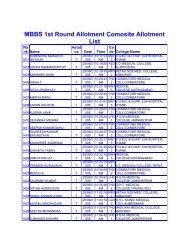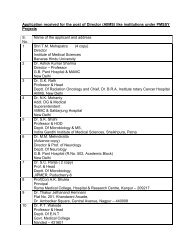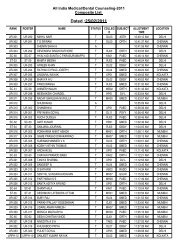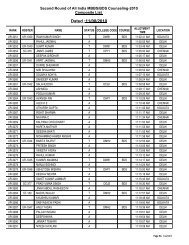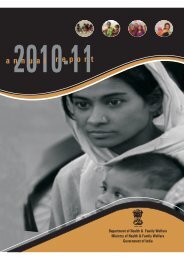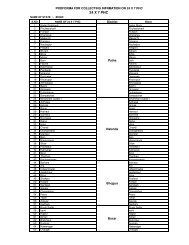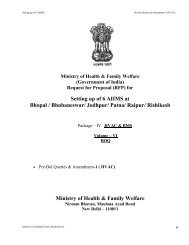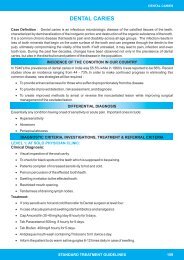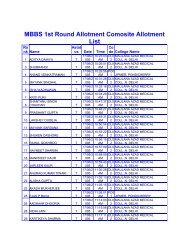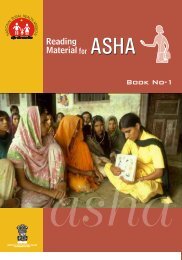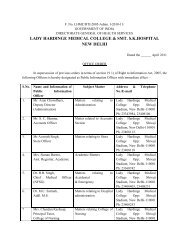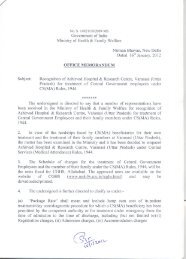National Vaccine Policy Book - Ministry of Health and Family Welfare
National Vaccine Policy Book - Ministry of Health and Family Welfare
National Vaccine Policy Book - Ministry of Health and Family Welfare
You also want an ePaper? Increase the reach of your titles
YUMPU automatically turns print PDFs into web optimized ePapers that Google loves.
The current dependence on a limited number <strong>of</strong> domestic vaccine<br />
producers leaves the UIP vulnerable to price increases <strong>and</strong> supply<br />
shortages. There is need for a few steps to be taken to address this<br />
issue:<br />
• Transparent evaluation criteria <strong>and</strong> effective contract monitoring<br />
systems need to be instituted along with establishment <strong>of</strong> an<br />
independent evaluation committee with binding outcomes to<br />
oversee all vaccine procurement.<br />
• Procurement timing has been out <strong>of</strong> step with the realities <strong>of</strong><br />
vaccine supply. UIP vaccines have a long production time, short<br />
shelf life, <strong>and</strong> a supply that must respond to the continuous birth <strong>of</strong><br />
babies with a specific schedule <strong>of</strong> needs. A multi year cycle <strong>of</strong><br />
procurement should be tried <strong>and</strong> contractual lead time increased<br />
to better match vaccine production cycles.<br />
• The current number <strong>of</strong> personnel attending to UIP procurement<br />
<strong>and</strong> distribution is not adequate for the magnitude <strong>of</strong> the task.<br />
Mechanisms to improve the efficiency <strong>of</strong> procurement <strong>and</strong><br />
distribution must be identified.<br />
• Quantities <strong>and</strong> delivery schedules for procurement <strong>of</strong> AD syringes<br />
must match vaccine quantity <strong>and</strong> delivery schedules.<br />
• Closer management <strong>of</strong> delivery schedules to ensure that overstocking<br />
<strong>and</strong> under-stocking in different states needs to be<br />
instituted.<br />
• An in-depth study <strong>of</strong> the distribution system – including lower<br />
levels, should be undertaken to evaluate factors considered for<br />
forecasting <strong>and</strong> determining supply requirements. This will be<br />
helpful in addressing the vaccine supplies <strong>and</strong> shortages at<br />
various levels in the country.<br />
6.4.1. <strong>Vaccine</strong> wastage<br />
An assessment <strong>of</strong> vaccine wastage in India, conducted in 2009<br />
revealed that wastage rates depended on formulation, presentation<br />
<strong>and</strong> was inversely proportional to session size. Both cold chain<br />
requirement <strong>and</strong> vaccine wastage is expected to increase several<br />
fold with the introduction <strong>of</strong> newer vaccines compared to the UIP<br />
vaccines. Smaller dose vial is recommended for vaccines that have<br />
only one dose in the UIP schedule (e.g. Single dose for birth dose <strong>of</strong><br />
HepB), <strong>and</strong> 2- 5 dose vials for the newer & more expensive<br />
vaccines). A huge amount <strong>of</strong> vaccine is damaged in the primary<br />
stores, which is beyond the scope <strong>of</strong> vaccine wastage study, needs<br />
to be factored in to. Adopting WHO multi-dose vial policy at session<br />
sites may be considered.<br />
6.4.2. Cold chain management<br />
Cold chain storage capacity in India has improved in recent years. A<br />
nationwide cold chain assessment in 2008 revealed the shortage <strong>of</strong><br />
cold chain equipment, <strong>of</strong> space allocation, <strong>and</strong> lack <strong>of</strong> preventive<br />
/corrective measures for breakdown <strong>of</strong> installed cold chain<br />
equipment facilities in immunization centers <strong>and</strong> storage facilities.<br />
The shortage <strong>of</strong> appropriately trained manpower to manage the cold<br />
chain logistics <strong>and</strong> equipment is another challenge.<br />
These cold chain management challenges can be addressed by:<br />
• Regional cold chain training cum support units should be<br />
established by GOI to provide appropriate support to the states.<br />
• Mechanisms <strong>and</strong> systems in place for independent auditing <strong>of</strong><br />
cold chain capacity,<br />
• Developing some basic st<strong>and</strong>ards <strong>of</strong> storage <strong>and</strong> vaccine stores<br />
as per the global st<strong>and</strong>ard <strong>and</strong> need to be circulated to the states<br />
• Regular self assessment <strong>of</strong> cold chain <strong>and</strong> vaccine management<br />
using st<strong>and</strong>ard global Effective <strong>Vaccine</strong> Management tool.<br />
6.4.3. <strong>Vaccine</strong> stockpile in disaster <strong>and</strong> outbreak situation<br />
The growing need is being felt to stockpile <strong>of</strong> vaccines against certain<br />
diseases with potential to cause outbreaks such as Cholera, JE <strong>and</strong><br />
H1N1 <strong>and</strong> other seasonal influenza. These vaccines are required for<br />
an affected target population <strong>and</strong> the quantity needed for stockpile<br />
should be assessed together with the <strong>National</strong> Disaster<br />
Management Agency (NDMA). This may be achieved by taking<br />
following step:<br />
• The manufacturers <strong>of</strong> these vaccines have to be communicated <strong>of</strong><br />
the decision ahead <strong>of</strong> time for planning production <strong>and</strong> when the<br />
stock expires or is utilized.<br />
• Adequate budgetary provision for such stockpiles should be<br />
created <strong>and</strong> adequate cold chain equipment earmarked for<br />
storage.<br />
24 25




